Dubai, the jewel of the Arab world, is one of the 7 emirates that make up the oil-rich Persian Gulf country of The United Arab Emirates (UAE). The tiny emirate, twice the size of London, is a kingdom built on the profits of its oil reserves and so one shouldn’t be surprised to learn that this is one of the richest places in the Arab world. But that hasn’t always been the case. As little as 60 years ago Dubai was a small trading town built on a humble creek. But oh how things have changed. A complete turnabout has totally transformed Dubai and today it is famous for trade, gold and all things luxury. Oh, and it’s also famous for its oil. For now that is because it’s estimated that by 2016 the oil reserves will have run out, spelling disaster for the oil-dependent economy.
– Kevin Costner, Field of Dreams
Forewarned of this impending doom, Dubai has been forced to reinvent itself & once again find new sources of income, and none other than the crown Prince himself is onto the task; he has a multibillion dollar plan to save his emirate, and thus the country, by rebranding it and transforming it into nothing less than the world’s number one luxury tourist destination. And with a plan in place for well over a decade now the Arabs certainly can’t be accused of not giving it their best shot. They have gone to some outrageous, almost superhuman lengths in an attempt to put Dubai on the high-rolling tourist map – they have constructed, or are in the process of constructing world class golf courses, race tracks, legions of luxury hotels, multimillion dollar apartment complexes, shopping malls, massive man-made islands and, for good measure, the world tallest building. The aim is to attract some 15 million people annually to spend their money here, 3 times the present figure. But that in itself causes problems, mainly problems of space. With only 72 kilometres of coastline, there wouldn’t be enough room for all the extra people. So what do the Arabs do to solve this issue? Well, they build islands of course, huge cities at sea with not only more space for all to enjoy but with yet more shopping malls, restaurants, exclusive multimillion dollar private beach villas, marinas, water theme parks, health spas & luxury hotels.
So that’s what they have been doing 24/7, 365 days a year since August 2001, reclaiming land at an almost impossible rate and building massive offshore archipelagos in the process, one of which is an island mock-up of the globe – not content with putting Dubai on the map, they are putting the map on Dubai. The result of all this madness means that Dubai can now boast of having over 1500 kilometres of sun-drenched, white sand coastline, man-made or otherwise. Problem solved. Yes, build it and they will come, or so the Arabs hope.
______________________________________________________
Building Islands in the Sun
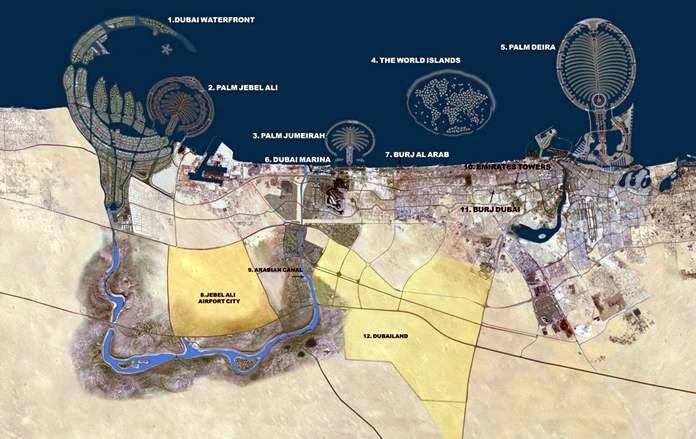
This is an aerial view of the Dubai (![]() ) shoreline just to give an overview of the madness going on here. This picture shows Dubai’s 3 palm tree-shaped archipelagos – (L-R) The Palm Jebel Ali, The Palm Jumeirah & The Palm Deira (‘The World’ archipelago can be seen between The Palm Jumeirah & The Palm-Deira). The Palm Jumeirah was the original project (work commenced on it in 2001) with The Palm Jebel Ali & The Palm Deira still presently under construction (The Palm Jebel-Ali is scheduled for completion later this year while the Plam Deira isn’t expected to be completed until 2015 at the earliest). Constructed with sand dredged from the bottom of the Persian Gulf and rock quarried in various parts of The United Arab Emirates, the islands are, not surprisingly, the largest land reclamation projects in the world. The scale of even the smaller Palm Jumeirah is massive (approximately 5 km²), so it’s evident from this picture how brave/ambitious the Arabs have got with subsequent projects – The Palm Jebel Ali is over twice the size of The Palm Jumeirah while the The Palm Deira nearly 8 times the size.
) shoreline just to give an overview of the madness going on here. This picture shows Dubai’s 3 palm tree-shaped archipelagos – (L-R) The Palm Jebel Ali, The Palm Jumeirah & The Palm Deira (‘The World’ archipelago can be seen between The Palm Jumeirah & The Palm-Deira). The Palm Jumeirah was the original project (work commenced on it in 2001) with The Palm Jebel Ali & The Palm Deira still presently under construction (The Palm Jebel-Ali is scheduled for completion later this year while the Plam Deira isn’t expected to be completed until 2015 at the earliest). Constructed with sand dredged from the bottom of the Persian Gulf and rock quarried in various parts of The United Arab Emirates, the islands are, not surprisingly, the largest land reclamation projects in the world. The scale of even the smaller Palm Jumeirah is massive (approximately 5 km²), so it’s evident from this picture how brave/ambitious the Arabs have got with subsequent projects – The Palm Jebel Ali is over twice the size of The Palm Jumeirah while the The Palm Deira nearly 8 times the size.
______________________________________________________
Dubai Observations || Under Construction
Look at a map, any map, of Dubai and you’re likely to see ‘UC’ printed all over it (ours do). It goes some way to highlight the scale of the construction going on over here. One way to get an appreciation for the seemingly unbridled development is to take a taxi ride – you’re never too far from a sea of cranes building the latest and greatest skyscraper, an army of earthmovers reclaiming more land from the Arabian Gulf or vast tracts of desert landscape been turned into the newest Pleasure Village complete with platinum card shopping centres, must have condos & sea-view apartments. It all leaves no doubt in our minds that there is indeed a lot of money in oil – the UAE is, for now, the 5th largest oil producer in the world. We estimate that if they keep building off-shore islands at the rate they are building them then by 2020 they should succeed in building a land bridge across the Arabian Gulf to the shores of Iran, some 200 kilometres away.
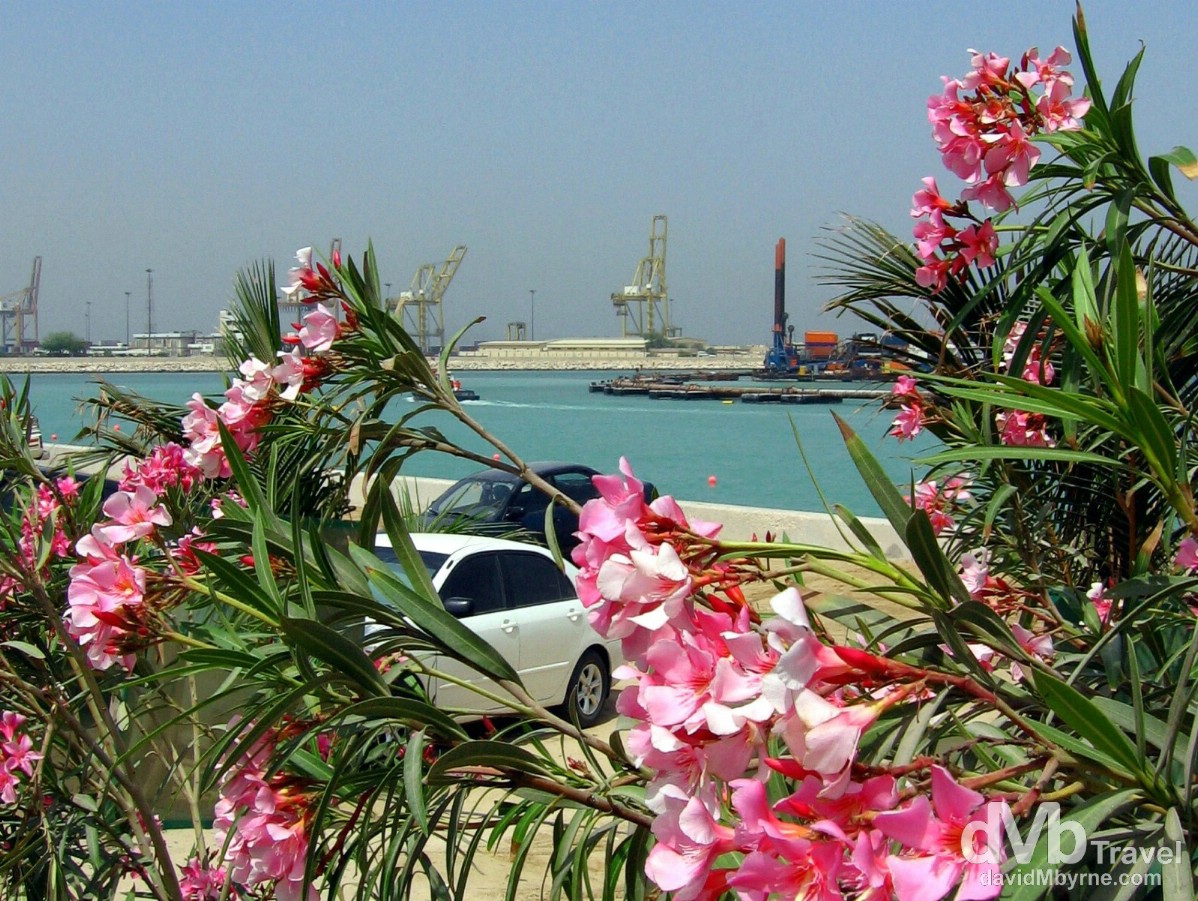
We wanted to try get a look at some of the work going on to create the islands being built in the Arabian gulf off the coast of Dubai but we soon realised that the sheer size of the projects means that to get any decent perspective on the madness of it all requires one to get airborne (or cheaper still fire up Google Earth). This is a rather lame picture showing distant work on The Palm-Deira archipelago, the nearest archipelago to downtown Dubai and the largest of the 3 palm tree-shaped archipelagos being constructed. The developer claims that with a planned surface area of 46.35 million m² it will cover a surface area larger than that of Paris. Development here began in 2003 and it is expected to be completed by 2015 at the earliest. Once completed it will be the largest man-made island in the world, a manmade island full of luxury hotels, exclusive residential beach side villas & apartments, marinas, water theme parks, restaurants, shopping malls, sports facilities, and health spas. Corniche Deira, Dubai, United Arab Emirates. April 7th, 2008.
______________________________________________________
Deira || Souqs & Tradition
Unless you like shopping or are the sort of person who gets off on viewing large scale construction projects (both on and offshore) then there isn’t much to do here in Dubai, apart from sweat and spend money (and the more of the latter that you have the better). As noted, the whole place has been built, or is being built, to attract tourists and the tourist dollar – present-day Dubai is development, air-conditioned duty free shopping centres, jewellery shops, palm trees lining manicured sprinkled lawns, 5 star hotels, celebrity chef restaurants and chauffeur driven limos. It’s all bling, Arab style. But there’s also old, traditional Dubai, and it’s a far cry from the newer, shinier Dubai.
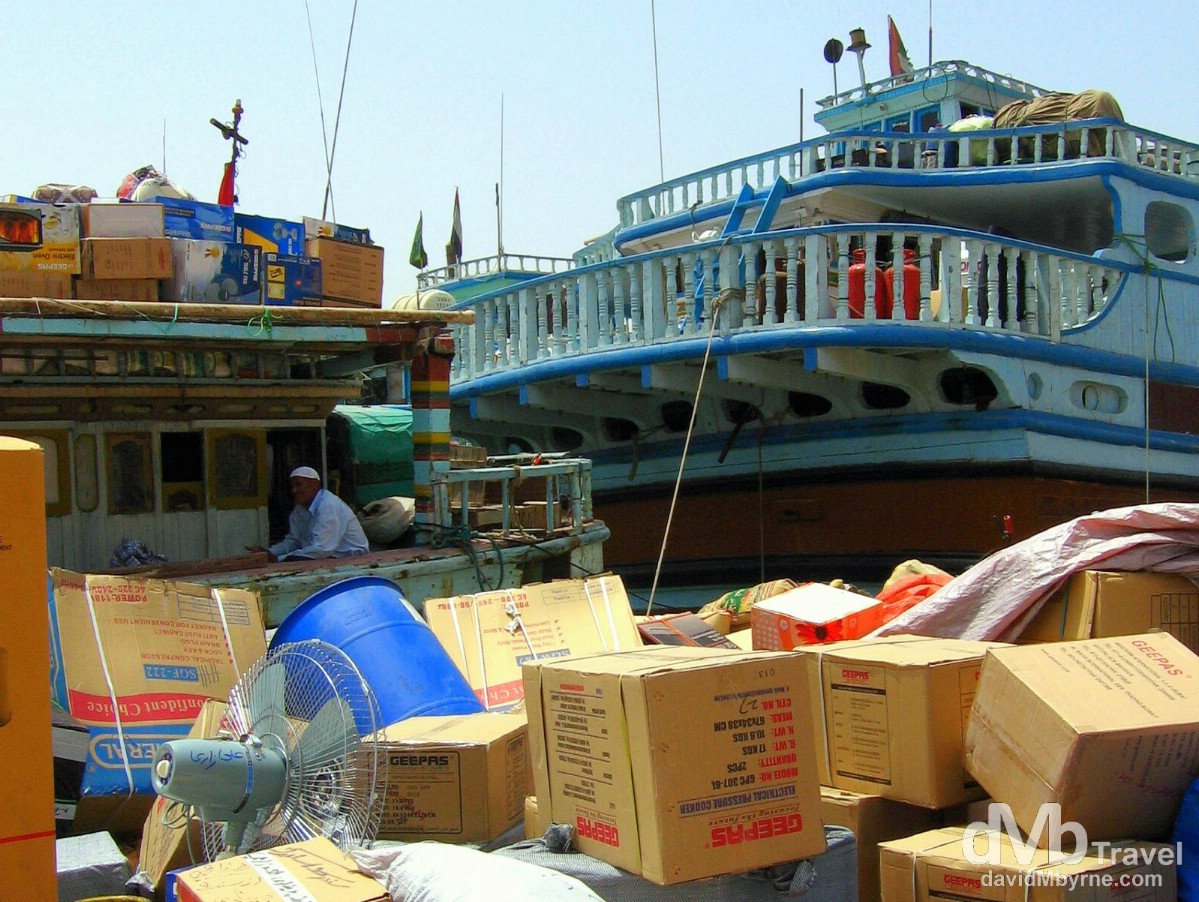
Goods lining Dubai Creek. The newness of modern Dubai is sharply contrasted by the old-world fishing village feel one gets down here by Dubai Creek. Here you can leave all the construction, bling and modernity behind and get a glimpse of Dubai’s trading heritage. The creek, a natural inlet from the gulf that bisects the city in two, was the site of the 1830s fishing village that modern day Dubai grew from. Here traditional wooden dhows (Arabian vessels, seen here) load up with goods and set sail for ports in India, the Gulf and East Africa just like they have done for generations. The sight of the locals loading and unloading cargo is a far cry from the glitz and glam on display in the other areas of the city, the areas of the city found in glossy brochures and marketed by Dubai tourism officials overseas. Dubai Creek, Deira, Dubai, United Arab Emirates. April 7th, 2008
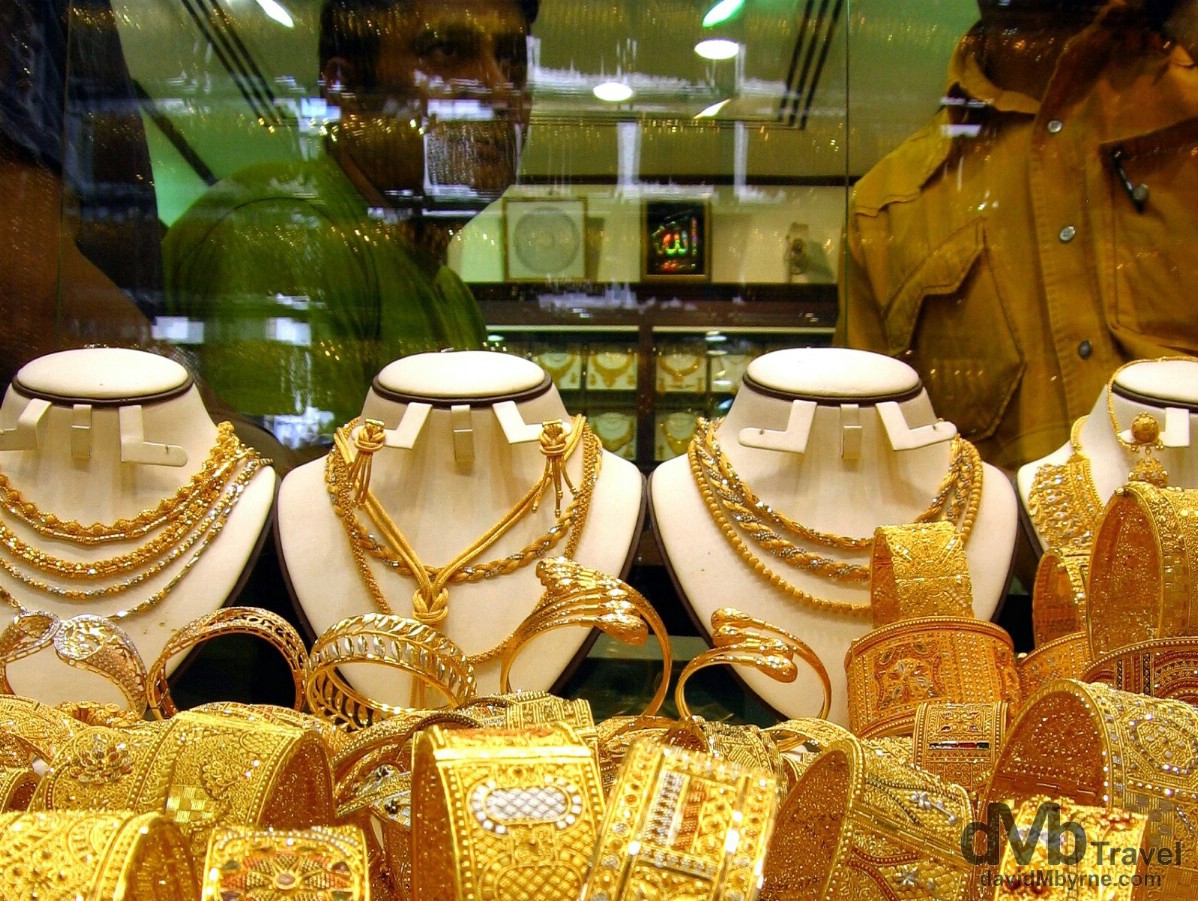
Bling in the Gold Souq (market) where, according to our Dubai map information, you can buy ‘everything from ingots to intricately worked jewellery at bargain prices.’ Well, while admittedly neither of us knows much about jewellery it all just looked like bling to us and bling that certainly didn’t come at what we would class as a ‘bargain’ price. Al Ras, Dubai, United Arab Emirates. April 7th, 2008.
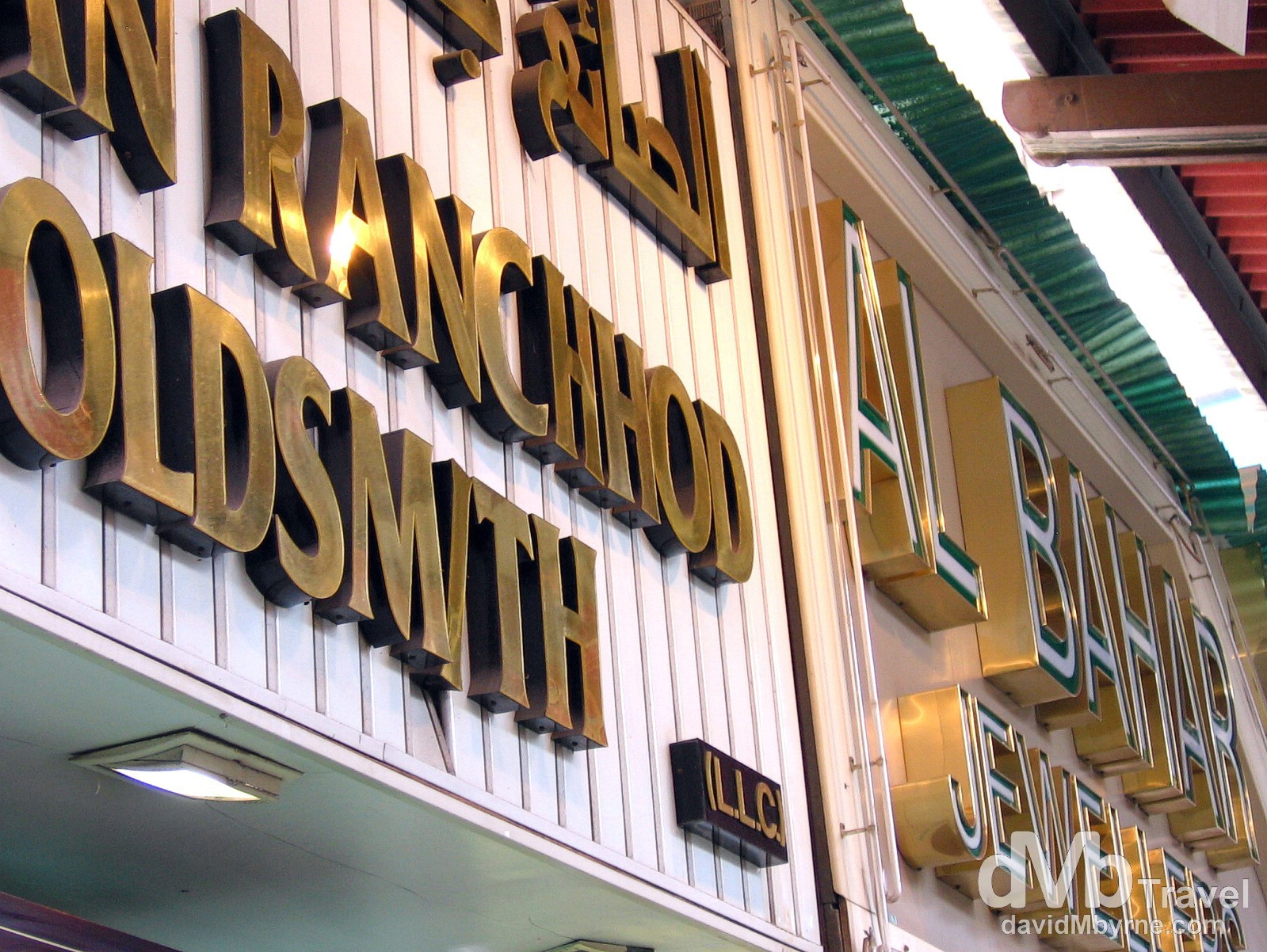
Shop fronts in the Gold Souq in Dubai, UAE. April 7th 2008.
Dubai Observations || $$$
A word of warning for the guys out there. Don’t take your girlfriend or wife to Dubai. It’s full of expensive hotels, duty free shopping centres and jewelry shops. She might love you for it but your credit card won’t.

Only when walking the tight lanes of Dubai’s Deira district would you get any indication that you were actually in an Arab/Muslim country, and even here the vast majority of the people on the streets are African immigrants and locals in western attire. It all goes to show how western Dubai is. You won’t see many 5-star hotel guests on these streets, unless of course they are peering at you from the comfort of their air-conditioned tour bus. On the streets of the Deira district of Dubai, United Arab Emirates. April 8th, 2008.
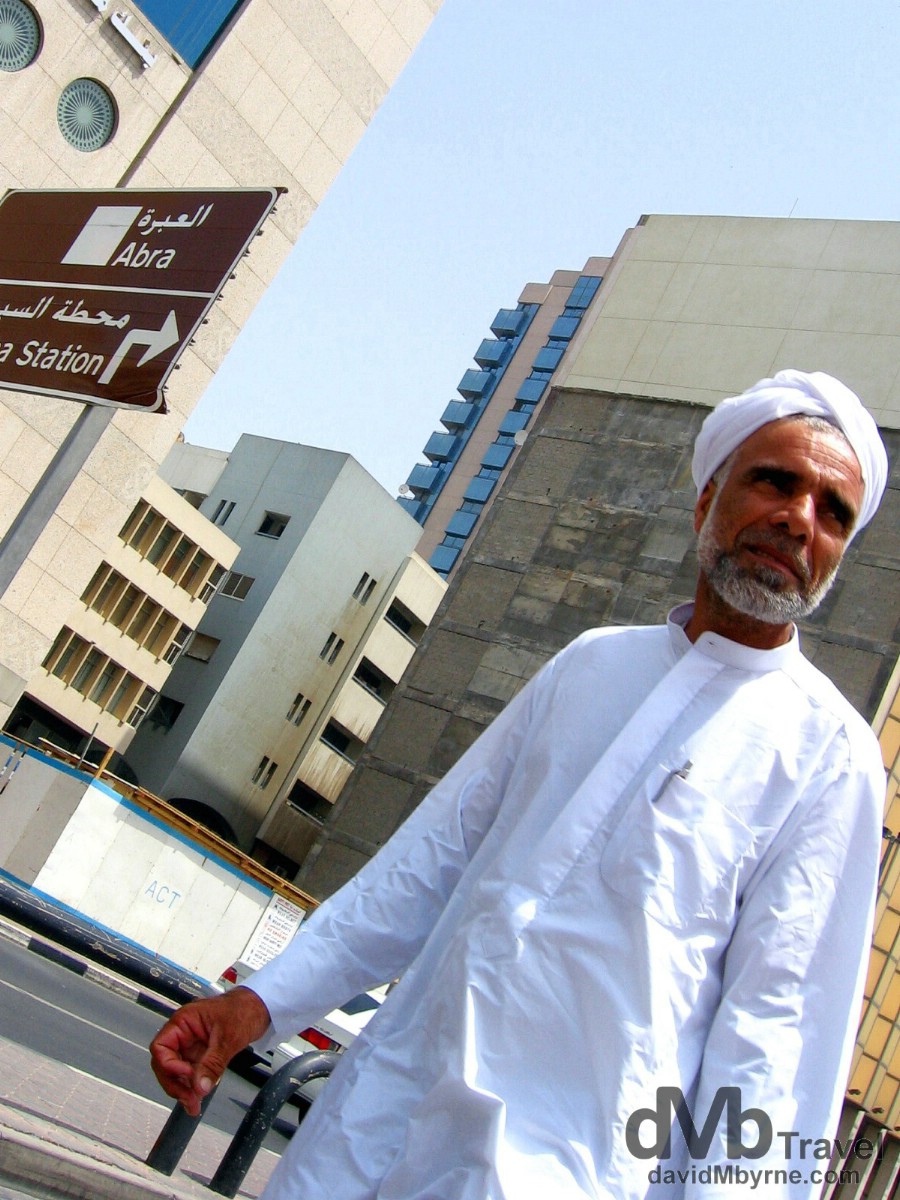
On the streets of the Deira district of Dubai, United Arab Emirates. April 7th, 2008.
______________________________________________________
The Irish Village
By the time last night (Monday) rolled around we had gone 3 nights without a beer. Three nights. So knowing full well that we could get a beer in any bar that calls itself an Irish bar (even in a Muslim country) we Googled ‘Irish bar Dubai’ and soon after found ourselves en route to Dubai’s Irish Village.
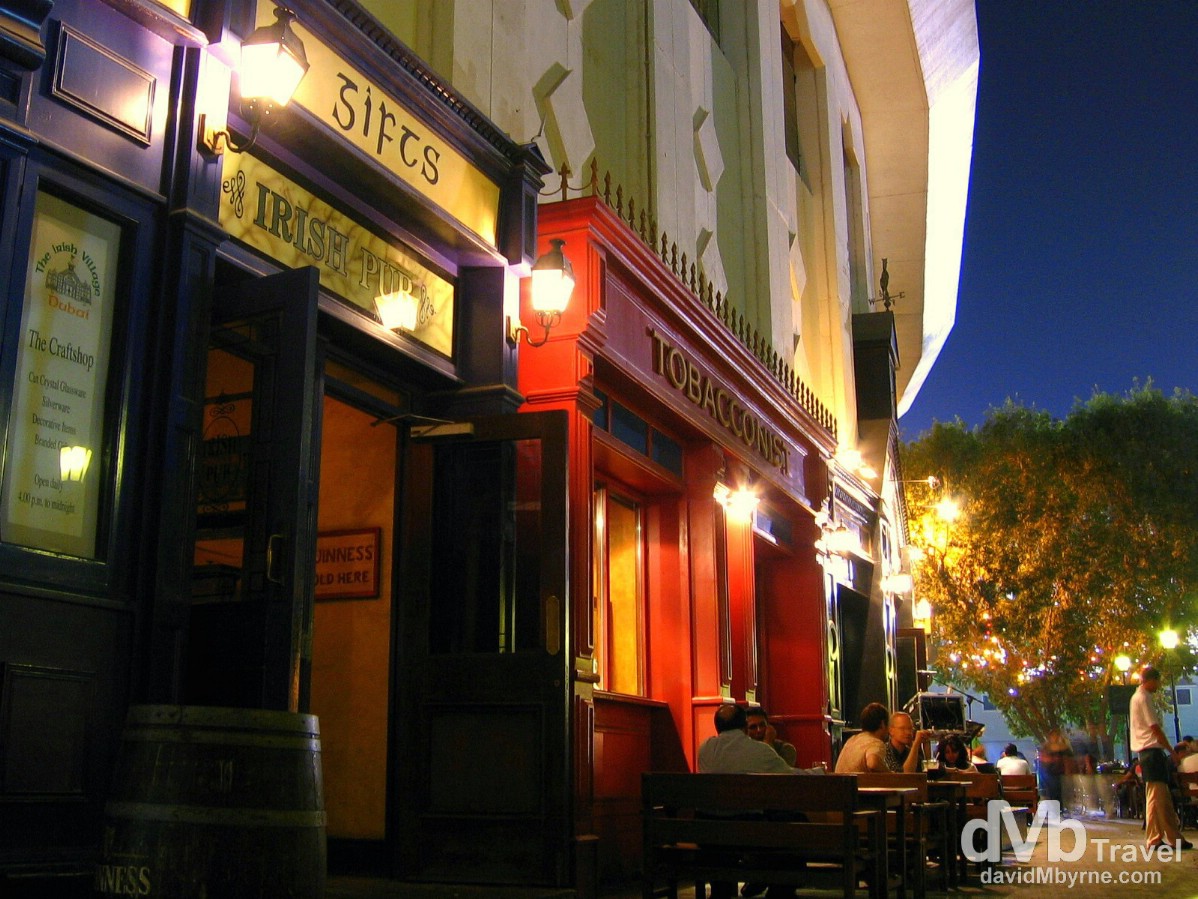
The Irish Village is a little bit of flat-pack, plastic Ireland in the middle of the desert. The large outdoor patio is fronted by facades of old Irish stalwarts – a post office, a tobacconist (even though I’ve never seen such a place at home) and of course the pub itself. There’s even an old style Telecom Eireann phone box (that I did recognise) and an An Post postbox. A sound system piping the greatest hits of Christy Moore, Paul Brady and, of course, U2 completed the home away from home feel, as did the Irish-esque prices for the beers. Still, it was worth the splurge and we even abandoned being backpackers for the night by getting dressed up for the occasion. The Irish Village, Al Garhoud, Dubai, United Arab Emirates. April 7th, 2008
______________________________________________________
Burj Dubai
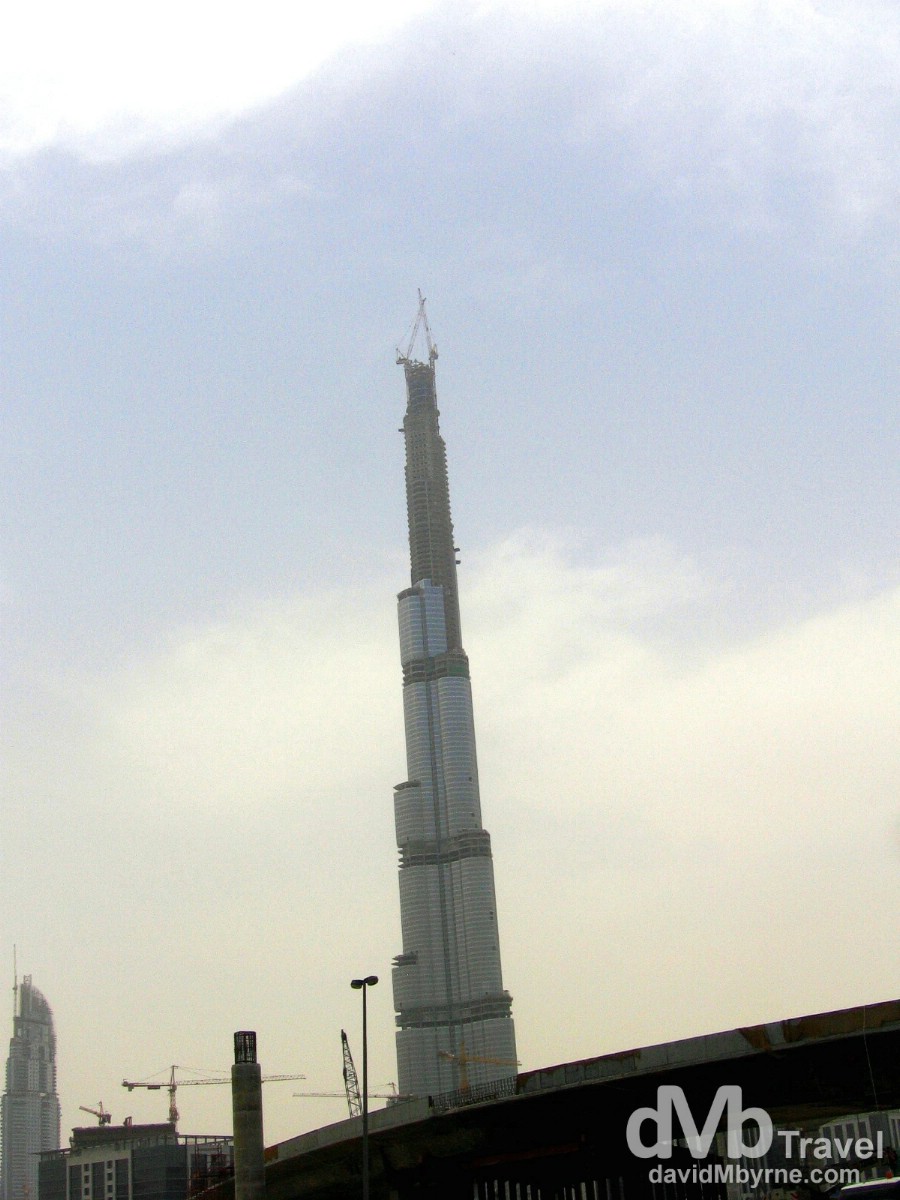
Under construction. Construction in Dubai, where evidently no project is deemed too outrageous or too ambitious, isn’t just confined to the sea, as the sight of untold numbers of inland cranes will testify to. This is the as yet unfinished Burj Dubai Tower, the centrepiece of the new $20 billion Downtown Burj Dubai, a large-scale mixed-use complex that upon completion will house, amongst other ambitious structures, a huge man-made lake and the largest shopping centre in the world. The exact finished height of the tower, scheduled for completion in 2009, is a closely guarded secret but it is expected to be over 800 metres high, easily making it the tallest building in the world (it already is the tallest even though it’s not yet completed). The first 50 floors will house offices and hotels, while the upper floors will hold multimillion dollar apartments. A terrible shot, it is unfortunately the only image I have of what I’ve no doubt will become a Middle Eastern icon. It was captured from a moving taxi en route to ogle at Dubai’s current most recognisable structure, the 7-star Burj Al Arab hotel. Dubai, United Arab Emirates. April 8th 2008.
Dubai Observations || Taxi
Taxis are quite cheap over here in Dubai, which is good considering you don’t really want to be out in the sun for any longer than you absolutely have to, distances are vast and the chronic traffic means going from A to B will take a lot longer than it should. We spent 2 hours in a taxi earlier today going to and from the 7-star Burj Al Arab hotel, somewhere we naively thought we could walk to when we first opened a map of Dubai. The bad news? Getting a taxi in the first place might take some time. We had to walk for a few kilometres last night before we eventually hailed a taxi to take us the rest of the way to The Irish Village, clearly earning our night out.
______________________________________________________
Burj Al Arab
– Sam Wollaston, The Guardian describing the Burj Al Arab
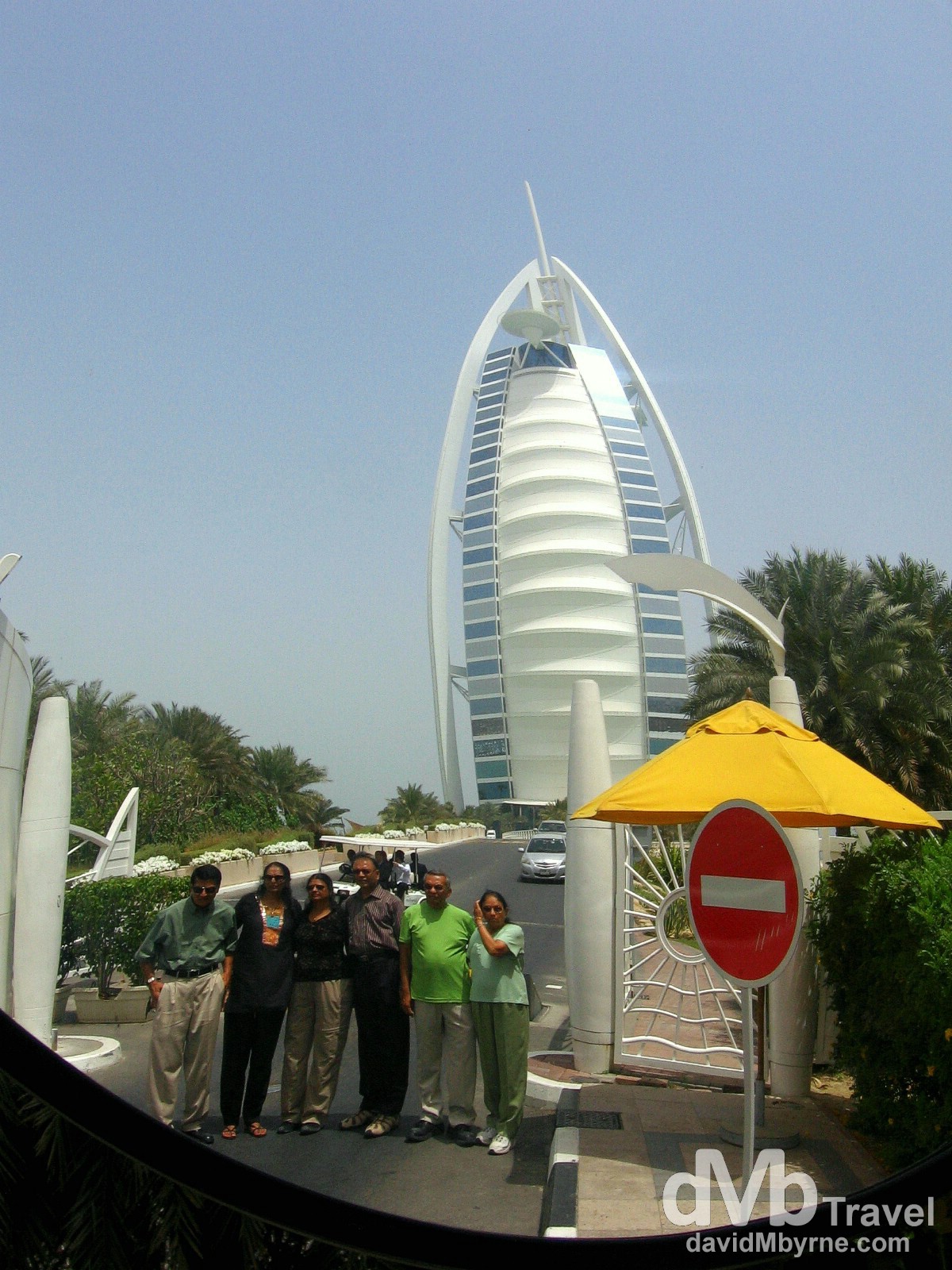
Dubai is home to an indoor ski resort, a water park that defies gravity (you slide up the slides, not down them), floating bridges and this, the Burj Al Arab hotel, the world’s only 7-star hotel (although more are presently being built in various parts of the world). I’m not sure what this place offers in order to achieve such a scale-altering rating but I’d be expecting nothing less than the last word in luxury, especially with the cheapest room costing $1,500 a night (if you have a spare $5,000 floating around you could splash out for the most expensive suite). Built at a cost of $650 million in the mid 1990s on a private island 280 metres into the sea, its design is in the shape of a sail of a dhow, a lateen-rigged sailing vessel used by Arabs & still seeing plying the water down at Dubai Creek, from where modern Dubai grew. Until recently it was the tallest hotel in the world (its 321 metre height has only recently been superseded by another Dubai hotel, the 333 metre Rose Tower). We decided against staying here as we wanted to stay somewhere more central but we did charter a taxi to take us here for a few pictures. And we weren’t the only ones pointing a camera at the structure; as one can see from this picture the Burj Al Arab is quite a tourist attraction, in a city devoid of recognisable monuments. This is a picture of the hotel reflecting in a nearby traffic mirror. For some reason this turned out to be a better picture of the hotel than any of the unobstructed pictures I captured. At the Burj Al-Arab hotel, Dubai, United Arab Emirates. April 8th 2008
______________________________________________________
Our Dubai
We got off the bus from Muscat, Oman, at 10pm two nights ago. We had no idea where in the city we were (the outskirts, we assumed), we had no map, we had no information on the city other than a hotel name, and we had no local currency, the UAE dirham. Somehow we made it to The Piccadilly Hotel on Nasser Square in the downtown Deira district which, at 375 AED a night (€66), is one of the cheapest places in town (but still a fortune to us two-days-removed-from-India penny pinchers). We didn’t really have anything we wanted to do here, apart from just being here, but we have spent yesterday and this morning visiting the city’s Gold and Spice Souqs (markets) and getting our picture in front of the 7-star Burj Al Arab hotel which, assuming your feet stay firmly on terra firma, is about the closest thing Dubai has to a recognisable landmark (for now). We also found time to book our flights to our next stop, Cairo, get drunk in The Irish Village, the only Irish bar in the city, and do a bit of shopping in one of Dubai’s legendary shopping centres, one we visited to escape the 36 degree plus temperatures (even if we did walk for hours in the baking sun to get there). All those activities saw us spending not only two nights in the city but also a small fortune and brought to an end our 3 night stop-off on the Arabian Peninsula en route to Egypt.
· A tip. Don’t try so hard
Maybe it was my fault. Maybe I shouldn’t have tipped so generously the Piccadilly Hotel porter who unnecessarily showed us to our room shortly after arriving. A few minutes later another porter knocked at the door of our room to know if everything was OK.
“Super, no bother. Thanks for asking,” we answered.
He then noticed that everything with our room was anything but super. The perfectly adequate TV sitting in the corner of our room had no remote control so he left to return minutes later with a replacement TV complete with remote control. This service may have warranted a tip had we requested the TV be replaced but as we hadn’t the porter left the room tip-less and no doubt grumbling that we weren’t as generous as his colleague had no doubt informed him we were.
· Rock Stars
“Here, last night Muscat, the night before Mumbai, tonight Dubai & in two night’s time we’ll be in Cairo. We’re like a band on tour,” Pat proclaimed shortly after settling into the Piccadilly Hotel and seeing off the latest tip-hunting porter.
“I suppose Lad, but I doubt any Rock Stars coming to Dubai would find themselves frequenting the Piccadilly Hotel,” I countered.
“True enough Dave, true enough.”
______________________________________________________
Check out my most recent visit to Dubai in April 2014.
______________________________________________________
